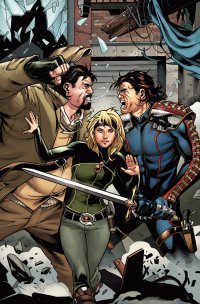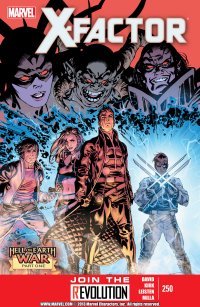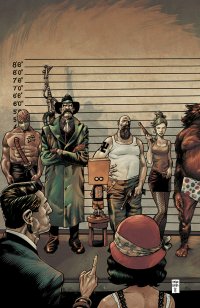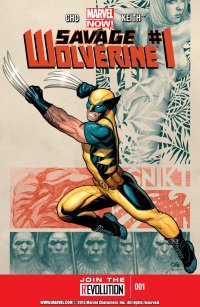Archer and Armstrong #6 ($3.99, Valiant)
by D.S. Randlett (@dsrandlett)
Early in its run, Archer and Armstrong has become one of the titles that I look forward to the most each month. I suppose that there are many reasons why this shouldn’t be. From League of Extraordinary Gentlemen to the Assassin’s Creed video games, the young “everything is true” genre has been getting a workout, and in danger of becoming rote. Why this is, I don’t really know. It is as if the impulse toward continuity that has infected (and, perhaps, corrupted) the comics put out by the big two has spread to all of our genre fiction. Of course, this is only lamentable when the creative folk behind the effort fail to pull it off. Then it just feels like a bad mashup, like someone simply taking two pop songs with similar time signatures and sticking them together. Of course, when writers and artists are able to pull off these “everything is true” worlds they can bring to light connections between characters and authors that you may not have considered (Moore’s League is great at this. Most of the time.) while advancing a story that feels new.
Archer and Armstrong does it right in most cases, mainly because it uses the “everything is true” genre as a background for its characters’ adventures rather than a focus for its storytelling. Writer Fred Van Lente walks a fine line, but does it with aplomb. He was tasked with, I presume, updating and revitalizing an obscure series from what has become a cult publishing line from the 90s. His world and his story feel very much of that time, but in all the best possible ways. The series’ own mythology, with its Geomancers and their defender immortals, is basically a riff on Terminator 2, and Van Lente has a real grasp on the dynamics that made that story work. He also has a grasp of just how paranoid the 90s were: when you had the public discourse’s absurd reactions to events like Waco or Ruby Ridge, and then the Y2K scare. Incorporating all of those absurd conspiracy theories into an “everything is true” style narrative is stroke of genius. Especially since Van Lente absolutely revels in absurdity here, at once mining these concepts for narrative drive and laughs. Archer and Armstrong walks the line between parody and dramatically compelling pulp with aplomb, and Van Lente’s scripts are to be commended for that.
The new arc beginning in this issue gets off to a strong start. The first five issues largely concerned Obadiah Archer’s break with his creepy cultist parents, who were part of a vast conspiracy theory conglomerate called The Sect. I feared that that story might end up wearing out its welcome, but the Dan Brown-ish conspiracy stuff shifts a bit into the background here while Van Lente and company explore other aspects of Archer and Armstrong’s (and Valiant’s) mythology. The last issue introduced us to the immortal Armstrong’s brother, the Eternal Warrior, a being tasked with defending the Geomancer, a cyclically reincarnated speaker for the Earth. The mythology’s only complicated if you try to explain it, it turns out, as the story unfolds it employs an efficient use of flashbacks to establish the ideas around it. Once you’re in it, the Geomancer mythology is actually pretty cool, and the identity of the new incarnation presents some pretty clever spins on the idea, even if they are a little bit on the nose.
The art, now by Emanuela Lupacchino (pencils) and Guillermo Ortego (inks) is pretty basic, but it fits Van Lente’s tone very well, and the action storytelling is very well done. There’s a real sense of momentum and danger to the action, which helps with Van Lente (who goes for the laugh more often than not) pull off his balancing act. For all the praise I’ve heaped on Van Lente, if the artists he’s working with didn’t strike the right balance his efforts would fall on their face.
Archer and Armstrong is one of 2012’s great surprises, and is continuing strongly into 2013. Well worth reading from the beginning, it’s a series that effectively balances comedy and adventure that feels like it has real stakes. In a world where old pulp characters are getting serious treatments, Archer and Armstrong is here to remind us that good pulp can makes us laugh as well as gasp.
Rating: 




Out of a Possible 5 Stars
 X-Factor #250 (Marvel, $3.99)
X-Factor #250 (Marvel, $3.99)
By Jeb D.
For the past few years, Peter David has been running X-Factor as his own little mini-franchise within the Marvel Universe: editorial seems to leave him pretty much alone, and in turn, he delivers consistent entertainment that both honors, and tweaks, the tropes and truisms of superhero comics (a recent installment had the zombified corpse of Robert E. Lee savaging those who showed insufficient respect for death, including superheroes, with their constant penchant for resurrection): think of X-Factor as the Marvel U equivalent of Galaxy Quest: a wryly humorous love letter from someone who knows the weaknesses, as well as the strengths, of the form, and embraces them both.
Given the corporate comics tradition of doing blowout issues to mark significant numeric milestones, it’s been fun to speculate just what David had in mind for #250. Would he break up the team? Well, he already did a run of recent stories that gave respectful (possibly temporary) sendoffs to key players, allowing him to shake up the roster a bit without getting into more trouble with General Lee. Would Jamie Madrox and Layla Miller get married? Well, yeah… but they actually did that off-panel, between issues 245 and 247. Would there be a snark-filled one-off adventure of Pip the Troll? That was issue 246, and in fact, David managed to deliver all the fun that implied while still making it synch with the overall storyline.
And now that issue #250 is here, we see… well, we see David starting a new story arc, but smoothly integrating such recent plot threads as ex-team member’s Darwin hunting down Rahne’s werewolf child (one of those butterfly-effect “innocent must die to prevent future catastrophe” deals), the reappearance of the now-soulless Guido “Strong Guy” Carosella, chase scenes, punchups, family dynamics, fractured alliances and stormy allegiances, and the coming to fruition of the hell-on-earth promised during the recent volcanic eruption in New York’s Botanical Gardens. It’s not a monster double-size issue, nobody dies, the world doesn’t end (not yet, anyway): it’s just the latest chapter in one of modern superhero comics’ slyest little pleasures.
Leonard Kirk is probably the best regular artist the book has had during David’s run, and he seems to be having a blast cutting loose this issue, with nice support from inker Jay Leisten and colorist Matt Milla.
As many readers know, David suffered a stroke late last year, and if that meant handing over the reins of the book to someone else, even temporarily, that would be completely understandable. But I’m going to hope for his recovery, not just for him and his family, but for my own selfish reasons: I want him to feel well enough to keep turning out this charming gem of a book.
Rating: 




Out of a Possible 5 Stars
Todd, the Ugliest Kid on Earth #1 (Image, $2.99) 
By Adam Prosser
Sometimes, a comic comes along at exactly the right time and place to capture the zeitgeist. It may be by design (for example, it’s not surprising that some comics try to bask in the reflected glory of whatever blockbuster movies are coming out), but it’s often sheer luck; a creator just happened to pick subject matter that was relevant to current events, or that syncs up with a surprise hit in another medium.
And sometimes you get the opposite of that, when a comic manages to be about exactly the wrong thing at the wrong time. Todd, the Ugliest Kid on Earth, by M. K. Parker and Ken Kristensen, is one of those latter books. It reflects the unfortunate flipside of Image Comics’ publication format, in which creators have complete control: there was no one to say, hey, maaaaaybe we shouldn’t publish a comic about a child murderer at this particular point in time. Of course, that highlights just how questionable it is to publish a comic about child murderers at ANY time, and while I feel there’s a certain hypocrisy involved in getting all squeamish when certain shocking ideas move from the abstract to the real world, it’s hard to see exactly who this comic is going to appeal to.
The comic itself has a structure surprisingly similar to an old-fashioned “suburban” kid’s comic—it reminded me oddly of Little Lulu or Little Archie, but of course the tone is pure South Park. A Korean girl named Kim moves into the neighbourhood and quickly fails to befriend the titular Todd Belluomo, a kid who wears a bag over his head at all times to hide his apparently hideous visage. Todd’s a good-hearted kid who’s constantly getting dumped on by life—his parents are verbally abusive to him, bullies pick on him, and by the end of the issue he’s been arrested for a crime he didn’t commit. That crime? The serial murder of a number of neighbourhood kids, including Kim, in what I legitimately found to be a shocking development.
Last week I reviewed The End Times of Bram and Ben, a comic that strove to be shocking and irreverent, but which I found surprisingly entertaining. Whereas I found Todd, a book similar in spirit, to be tiresome and stupid and offensive. Funny, huh? I do feel the need to point out that Bram and Ben largely takes aim at religion, a subject I’m pretty much completely neutral about (at least, as neutral as anyone can be), whereas Todd deals with, obviously, subject matter that’s particularly sensitive right now (and tries to squeeze in some other topical humour, generally failing pretty badly—the closest thing to a witty exchange comes when Todd’s dad claims Obama’s pro-gay marriage policies are an extension of his pro-torture policies, ‘cuz it’s like torture for the gays, y’see) So I’m prepared to accept that I might be blinkered and biased in this particular matter, but I can’t help but feel that NO ONE is going to appreciate this kind of subject matter without the humour to back it up, and this comic just isn’t funny for the most part.
What’s almost worse is that I can’t completely write it off as utter crap, because it is undeniably very well crafted. Kristensen is apparently a screenwriter, though I don’t believe any of his scripts have been produced as movies, and he knows how to structure his story. In fact, viewed through the lens of horror instead of comedy, this could be considered a surprisingly strong comic, with Perker’s grotesque figures and surprisingly moody inking adding to the overall unsettling tone. In fact, said tone may be part of what turned me off this comic, despite the fact that a number of other entertainments that I enjoy—including Adventure Time and The Goon–go for a similarly queasy mix of creepiness and humour. I don’t know. Part of me feels that I’m somehow being unfair to this comic, and maybe it’s worth keeping an eye on. But right now it’s proof of a philosophy of mine: breaching the bounds of good taste is an admirable goal, but only if you have the talent to back it up.
Rating: 




Out of a Possible 5 Stars
 Savage Wolverine #1 (Marvel, $3.99)
Savage Wolverine #1 (Marvel, $3.99)
By Jeb D.
So, given your choice, which more or less predictable concept would you spring for: another Wolverine comic, or another comic where Frank Cho draws dinosaurs, and scantily-clad women with Lynda Carter’s face?
Lucky you: they’re both here!
This is one of those what-it-says-on-the-tin books: Wolverine and Shanna the She-Devil are stranded in the Savage Land, up against ferocious beasties, hostile aboriginals (treated reasonably well, given the context), and maybe a villainous coverup or two. The art’s as clean and pretty as you’d expect from Cho (with colorist Jason Keith), he does a perfectly fine interior monolog for Logan, and hits the expected notes in the super-powered meet-cute between our protagonists. It’s a simple pulp adventure, professionally executed, with promise of more to come.
Self-recommending for Cho fans, Shanna fans, and Wolverine fans. I think that’s probably enough buyers that they won’t miss your four bucks at all.
Rating: 




Out of a Possible 5 Stars